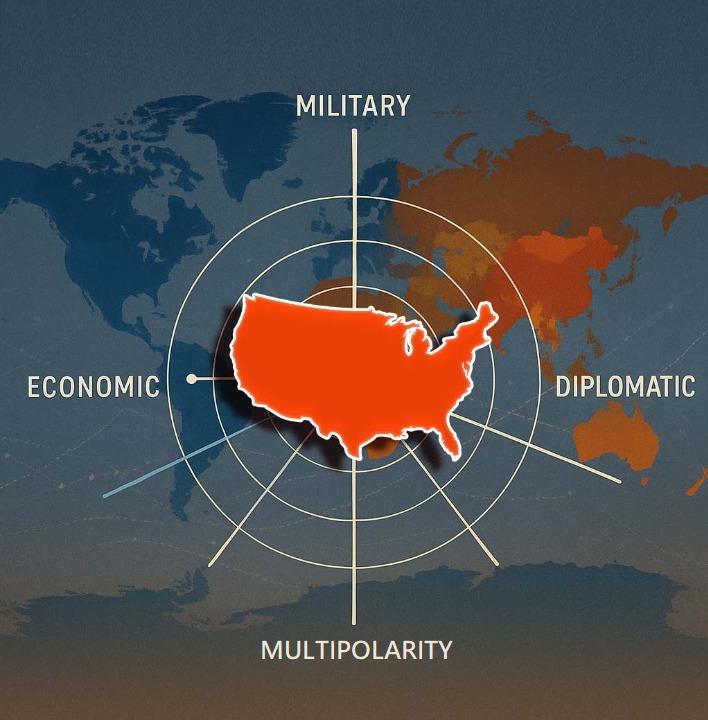
- A central conclusion is that U.S. hegemonic decline is less a matter of absolute loss of capability and more a matter of relative increase in the capabilities of other players—particularly China, but also India, Russia, and regional groupings like the BRICS and ASEAN.
- The United States’ share of global military spending has decreased to about 32%, despite an increase in defence spending in absolute terms from about $300 billion in 2000 to over $880 billion in 2024.
- China’s and Russia’s global alignment rates have increased, especially in the Global South, while the United States’ has slightly decreased between 2000 and 2024.
- The challenge for the U.S. will be to transform from hegemon to primus inter pares—first among equals—while protecting its core interests and contributing to global stability.
In the last quarter-century, the configuration of global power has changed fundamentally. From the early 2000s—when America was the unchallenged unipolar hegemon—to the current ascendant multipolar order, the realignment of economic, military, and diplomatic power has been among the most salient aspects of the 21st century. This report offers a data-intensive examination of that shift, combining macroeconomic trends, defence budgets, multilateral voting alignment, and infrastructure diplomacy.
The purpose is two-fold: first, to measure the relative decline in the U.S. percentage of world capabilities; and second, to place these trends in the larger context of the evolution toward a multipolar system of international relations. Although the United States is still the most dominant state in terms of several aspects, its relative predominance—the percentage share of world GDP, military expenditures, and diplomatic alignment—has progressively declined.
This research employs data from the International Monetary Fund (IMF), Stockholm International Peace Research Institute (SIPRI), UN General Assembly (UNGA) voting database, and various open-source economic and geopolitical datasets. The time frame covered is 2000–2024, with interpolations as needed to present continuous annual trends. Visualisations have been added to display changes in top metrics over time.
A central conclusion is that U.S. hegemonic decline is less a matter of absolute loss of capability and more a matter of relative increase in the capabilities of other players—particularly China, but also India, Russia, and regional groupings like the BRICS and ASEAN. The transition is lopsided: economic multipolarity is moving very fast, military multipolarity is gaining ground less quickly, and diplomatic multipolarity is still dominated by vested alliances.
This report has been structured into four principal sections: (1) Redistribution of Economic Power, (2) Balances of Military Power, (3) Realignments of Diplomacy, and (4) The Multipolarity Index—a weighted composite of the three dimensions. Each incorporates quantitative data, context analysis, and implications for the future.
1. Economic Power Redistribution
In the early 21st century, the U.S. economy contributed over 30% of nominal GDP in the world, with its closest rival, the European Union, lagging. China at the time was less than 4% of the world’s economy. Twenty years on, the situation is radically different.
Nominal GDP Share Trends: The nominal GDP of the United States increased from about $10 trillion to over $28 trillion between 2000 and 2024. However, the U.S. share decreased from roughly 30% to roughly 23% as the global GDP grew more quickly. China’s explosive growth—its share increased from 3.6% to over 17%—as well as consistent increases from emerging economies like Brazil and India, are the main causes of this relative decline.
Purchasing Power Parity (PPP) Adjustments: The transition is even more noticeable when expressed in PPP terms. Around 2014, China overtook the United States in PPP GDP, and as of 2024, it accounts for roughly 19% of the world economy, compared to 15% for the United States. This suggests that a large portion of China’s economic power stems from its ability to produce and consume domestically, which it can then use to exert influence internationally.
Structural Shifts: The shift in economic weight is not merely quantitative. U.S.-led multinational firms controlled consumer goods, technology, and finance in the early 2000s. Global supply chains are now much more dispersed, and Chinese companies are at the forefront of industries like 5G infrastructure, electric vehicle production, and renewable energy manufacturing. While Southeast Asia is becoming a major centre for electronics manufacturing, Indian companies are increasing their influence in the pharmaceutical and IT services industries.
The ramifications for global governance are significant. Western voting shares have historically dominated organisations like the World Bank and IMF, but there are growing calls for reform to reflect these new realities. Similarly, regional blocs are increasingly influencing trade agreements, like the RCEP in Asia, which lessens the United States’ influence over international trade standards.
The redistribution of economic, military, and diplomatic power has been among the most salient aspects of the 21st century.
2. Military Power Balances
The foundation of American hegemony has long been military supremacy. Over 37% of all military spending worldwide was allocated by the United States in 2000; in the early years of the War on Terror, this percentage increased to over 40%. This dominance was supported by a global network of military installations, superior force projection capabilities, and cutting-edge defence technology.
Absolute vs. Relative Spending: The United States’ share of global military spending has decreased to about 32%, despite an increase in defence spending in absolute terms from about $300 billion in 2000 to over $880 billion in 2024. The rise of China (now accounting for about 14% of global spending), Russia (between 4% and 5%), and the overall increase in middle-power spending are all reflected in this relative decline.
Capability vs. Numbers: It is crucial to remember that spending numbers by themselves do not adequately represent qualitative capabilities. In terms of long-range precision strike systems, stealth aircraft, and blue-water naval power, the United States continues to have a significant advantage. However, any possible military intervention in Taiwan is becoming more and more risky due to China’s anti-access/area-denial (A2/AD) capabilities, which have undermined American dominance in the Western Pacific.
Alliances and Forward Deployment: Strong military ties—NATO in Europe, bilateral security agreements in East Asia, and defence cooperation in the Middle East—continue to be advantageous to the United States. Although these partnerships increase American influence and deterrence, they also come with hefty resource commitments that limit adaptability.
Technological Competition: Autonomous systems, cyber capabilities, and hypersonic missiles are examples of emerging technologies that are becoming fiercely competitive. Traditional U.S. military dominance cannot readily overcome the asymmetric challenges posed by China’s quick advancements in these areas and Russia’s disruptive use of hybrid warfare.
3. Diplomatic Realignments
Voting trends at the UN General Assembly provide a helpful proxy for diplomatic influence, which is more difficult to measure than military or economic might. We can monitor shifts in international diplomatic blocs by looking at alignment scores, which quantify how frequently nations vote in accordance with the United States.
China’s and Russia’s global alignment rates have increased, especially in the Global South, while the United States’ has slightly decreased between 2000 and 2024. Changing economic ties are partially to blame for this; countries that trade with China more frequently are more likely to support it in multilateral fora.
The Belt and Road Factor: Since its launch in 2013, China’s Belt and Road Initiative (BRI) has been a major driver of diplomatic outreach. By 2024, more than 150 countries had signed BRI agreements, many of which included infrastructure funding. Despite detractors pointing to debt risks, many recipient countries see these projects as tangible benefits, in contrast to slower-moving Western development aid.
U.S. Diplomacy in a Multipolar Era: Washington is still involved in diplomacy, but it is no longer able to garner broad support, particularly from outside its core allies. Voting blocs are becoming more divided on issues like global health, technology governance, and climate change.
Regional Organisations: U.S. influence has become even more complex with the emergence of regional organisations like the African Union, ASEAN, and the Shanghai Cooperation Organisation (SCO) as autonomous diplomatic actors. These groups have more clout because they frequently coordinate their positions before confronting Western powers.
4. The Multipolarity Index
We developed a Multipolarity Index to combine the diplomatic, military, and economic aspects into a single metric. Using weighted scores from the three domains, this index is scaled from 0 (complete U.S. unipolar dominance) to 1 (fully balanced multipolarity).
With an index of roughly 0.22 in 2000, a strong unipolar environment was indicated. It increased to 0.61 by 2024, indicating a notable diffusion of power. The global financial crisis, China’s post-WTO growth boom, and the resurgence of Russian assertiveness all contributed to the majority of the increase between 2008 and 2020.
Regional Variation: Different regions have different levels of multipolarity. The index is closer to 0.75 in East Asia, suggesting that Chinese and American influence are about equal. The number is lower in Europe (0.45), where the U.S. presence is still anchored by NATO and EU institutions. There are conflicting trends in Africa and Latin America, with the United States maintaining its soft power advantages while China gains clout through trade and investment.
Future Directions: The index may reach 0.7 by the early 2030s, indicating a genuinely multipolar system, if present trends continue. However, this trajectory could be accelerated or reversed by unforeseen shocks like wars, technological advancements, or systemic crises.
The U.S. is still a powerful world power, but its period of unchallenged leadership is over.
Conclusion
The numbers speak for themselves: the U.S. is still a powerful world power, but its period of unchallenged leadership is over. The rise of China’s economy, the consistent increase of other emerging economies, the decline of the relative percentage of U.S. military expenditure, and the gradual shifting of diplomatic alliances are all part of a systemic reorientation toward multipolarity.
For policymakers, this translates into adjusting to a more competitive world in which leverage has to be established through coalition management, technological leadership, and strategic economic alliances. For analysts, this translates into understanding that multipolarity does not necessarily denote instability—historically, balanced power systems have been both conflictive and cooperative, depending on the governance mechanism prevailing.
The challenge for the U.S. will be to transform from hegemon to primus inter pares—first among equals—while protecting its core interests and contributing to global stability.
Divyanka Tandon holds an M.Tech in Data Analytics from BITS Pilani. With a strong foundation in technology and data interpretation, her work focuses on geopolitical risk analysis and writing articles that make sense of global and national data, trends, and their underlying causes. Views expressed are the author’s own.
